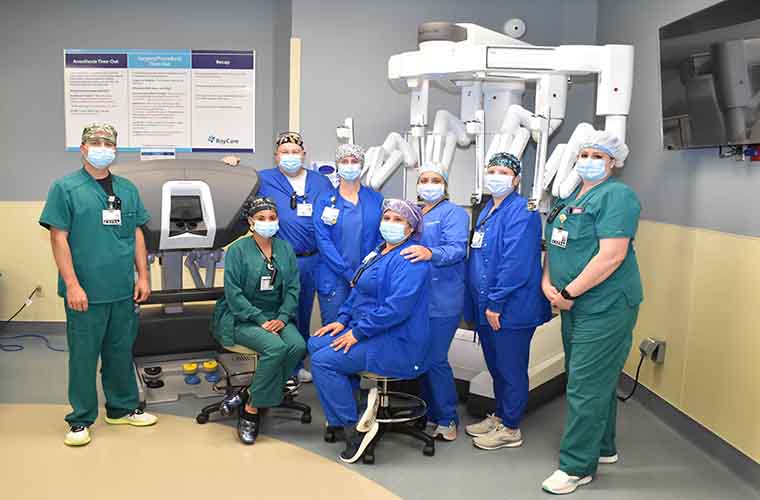Robotic Surgery
St. Joseph’s Hospital-South offers a wide range of robotic-assisted surgical procedures. Robotic surgery is a type of minimally invasive surgery, offering unprecedented accuracy and a shorter recovery period. At St. Joseph’s Hospital-South, our surgeons use the da Vinci® Surgical System, the most advanced surgical system available.
Center of Excellence
St. Joseph’s Hospital-South is an accredited Center of Excellence by the Surgical Review Corporation for practicing the gold standard of evidence-based surgical care. This accreditation distinguishes our hospital from other by providing the highest quality of care to its patients and meeting nationally recognized standards.
Robotic Surgery at St. Joseph’s Hospital-South
Robotic surgery refers to the surgical system we use to perform the procedure. Our expert surgeons are controlling the procedure from beginning to end. You can feel confident that you are in capable, experienced hands at St. Joseph’s Hospital-South. Features of our robotic program include:
- Experience - Our surgeons and team undergo extensive training in order to use the robotic system effectively. That is why we are a Center of Excellence.
- Effective, safe surgery - Robotic surgery offers many benefits, including less pain and a more precise surgery.
- Personalized approach - Surgical care is not one-size-fits-all. We work with you to tailor a surgical plan that offers you the best result. Not every patient is a candidate for robotic surgery. Our team has extensive experience in all types of surgical procedures. We always have your well-being and long-term health in mind when creating your surgical plan.

St. Joseph's Hospital-South Earns Robotic Center of Excellence Designation
Robotic Procedures We Perform at St. Joseph’s Hospital-South
We are constantly expanding the list of robotic-assisted surgeries that we perform. Our skilled surgeons perform many procedures, including:
- Bladder prolapse repair
- Endometriosis resection
- Hysterectomy with bilateral salpingo-oophorectomy
- Myomectomy
- Sacrocolpopexy and sacrospinous ligament fixation
- Salpingo-oopherectomy
- Supracervical hysterectomy
- Total hysterectomy
- Vaginal hysterectomy
- Abdominal hysterectomy
- Bilateral salpingo-oopherectomy
- Excision of pelvic tumor
- Hysterectomy with bilateral salpingo-oophorectomy
- Omentectomy
- Pelvic lymph node dissection (partial)
- Radical hysterectomy
- Single-site hysterectomy
- Supracervical hysterectomy
- Nephrectomy or partial nephrectomy
- Partial and radical cystectomy
- Ileal conduit urinary diversion
- Prostatectomy
- Ureteral reimplantation
- Advanced reconstructive procedures
- Abdominal perineal resection
- Colectomy/Colon resection
- Colostomy
- Gastrectomy
- Ileocecectomy
- Ileostomy
- Lower anterior resection
- Rectopexy
- Repair of rectovaginal and colovaginal fistula
- Sigmoidectomy
- Small bowel resection
- Transanal excision of rectal mass
- Lymph node biopsy
- Adrenalectomy
- Anti-reflux surgery (Nissen fundoplication)
- Gallbladder surgery (cholecystectomy)
- Heller myotomy
- Hernia repair
- Splenectomy
- Stomach cancer treatment
Robotic Surgery vs. Traditional Surgery
In the past, traditional open surgery has been the most effective treatment for gynecological conditions. However, traditional surgery requires a large abdominal incision to access the area and can lead to a long, painful recovery. Due to incredible advances in robotic technology, patients can now benefit from far less invasive surgeries for the treatment of gynecological conditions. Surgeons may use a robotic procedure to treat many gynecologic conditions.
Advantages include:
| Traditional Surgery | Robotic Surgery | |
| Incision Type | A large incision is required to access the uterus and surrounding anatomy. | Multiple small incisions allow the doctor to access the affected anatomy with a low level of invasiveness. |
| Risk to surrounding organs and nerves | Due to the highly invasive nature of open surgery, there is far more risk to organs and nerves. | The precision and accuracy of the small robotic instruments greatly reduces the risk to surrounding tissues. |
| Risk of blood less and infection | A large incision increases the risk of blood loss and infection. | The small incisions greatly decrease the risk of blood loss and infection. |
| Recovery period | Recovery after open gynecological surgery can often be long and painful. | Recovery after minimally invasive robotic surgery is shorter and less painful. |
For a physician referral, call (813) 644-6677 or find a surgeon near you.
Location:
St. Joseph's Hospital-South
6901 Simmons Loop
Riverview, FL 33578
Map & Directions

